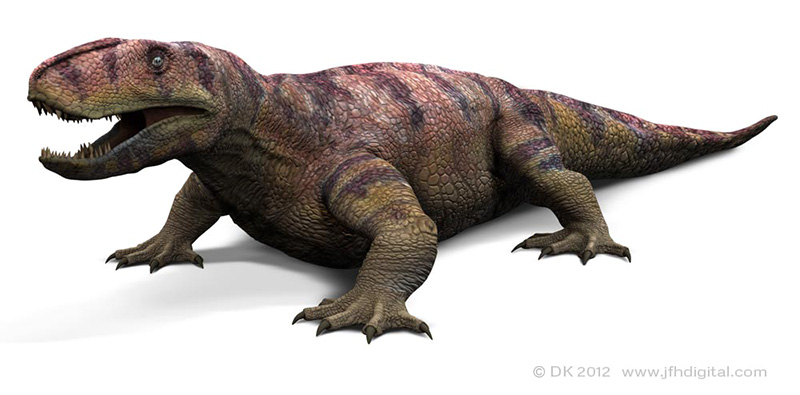Post by An Goldish Jade on Jul 11, 2017 14:39:12 GMT 5
Ophiacodon spp
Ophiacodon (meaning "snake tooth") is an extinct genus of synapsids belonging to the family Ophiacodontidae that lived from the Late Carboniferous to the Early Permian in North America and possibly Europe. The genus was named along with its type species O. mirus by paleontologist Othniel Charles Marsh in 1878 and currently includes five other species. As an ophiacodontid, Ophiacodon is one of the most basal synapsids and is close to the evolutionary line leading to mammals.
Ophiacodon has a large skull with a deep snout. It has the longest skull of any early synapsid, reaching up to 50 centimetres (20 in) in one specimen. The jaws are lined with many small teeth. It was larger than most other tetrapods (four-limbed vertebrates) of its time, ranging from 1.6 to 3 metres (5.2 to 9.8 ft) in length and 26 to 230 kilograms (57 to 507 lb) in weight.
Specimens of Ophiacodon vary greatly in size. These differences in size were once used to distinguish species, but are now recognized as ontogenetic variations related to the ages of individuals. Smaller bones often have more poorly developed joint surfaces than larger bones, implying that they come from juvenile individuals while the larger bones come from adults. Analysis of the histology or microscopic anatomy of bones suggests that differences in size represent different growth stages rather than different species.

Cuban crocodile-Crocodylus rhombifer
The Cuban crocodile (Crocodylus rhombifer) is a small species of crocodile found only in Cuba. Typical length is 2.1–2.3 m (6.9–7.5 ft) and typical weight 70–80 kg (150–180 lb). Large males can reach as much as 3.5 m (11 ft) in length and weigh more than 215 kg (474 lb). Despite its modest size, it is a highly aggressive animal, and potentially dangerous to humans.
The Cuban crocodile is of interest to biologists for its unique physical and behavioral traits. Long- and strong-legged, it is the most terrestrial of extant crocodiles. Its preferred habitat comprises freshwater environments such as marshes and rivers. There, the adults feed on fish, turtles and small mammals, while the young eat invertebrates and smaller fish. Mating occurs between May and July. Captive animals have displayed cooperative hunting behavior and could be taught tricks.
The Cuban crocodile is listed as Critically Endangered by the International Union for Conservation of Nature. Once spread across the Caribbean, its range has dwindled to including only the Zapata Swamp and the Isle of Youth, due to hunting by humans. Captive breeding projects are in place to help the species recover.

Ophiacodon (meaning "snake tooth") is an extinct genus of synapsids belonging to the family Ophiacodontidae that lived from the Late Carboniferous to the Early Permian in North America and possibly Europe. The genus was named along with its type species O. mirus by paleontologist Othniel Charles Marsh in 1878 and currently includes five other species. As an ophiacodontid, Ophiacodon is one of the most basal synapsids and is close to the evolutionary line leading to mammals.
Ophiacodon has a large skull with a deep snout. It has the longest skull of any early synapsid, reaching up to 50 centimetres (20 in) in one specimen. The jaws are lined with many small teeth. It was larger than most other tetrapods (four-limbed vertebrates) of its time, ranging from 1.6 to 3 metres (5.2 to 9.8 ft) in length and 26 to 230 kilograms (57 to 507 lb) in weight.
Specimens of Ophiacodon vary greatly in size. These differences in size were once used to distinguish species, but are now recognized as ontogenetic variations related to the ages of individuals. Smaller bones often have more poorly developed joint surfaces than larger bones, implying that they come from juvenile individuals while the larger bones come from adults. Analysis of the histology or microscopic anatomy of bones suggests that differences in size represent different growth stages rather than different species.

Cuban crocodile-Crocodylus rhombifer
The Cuban crocodile (Crocodylus rhombifer) is a small species of crocodile found only in Cuba. Typical length is 2.1–2.3 m (6.9–7.5 ft) and typical weight 70–80 kg (150–180 lb). Large males can reach as much as 3.5 m (11 ft) in length and weigh more than 215 kg (474 lb). Despite its modest size, it is a highly aggressive animal, and potentially dangerous to humans.
The Cuban crocodile is of interest to biologists for its unique physical and behavioral traits. Long- and strong-legged, it is the most terrestrial of extant crocodiles. Its preferred habitat comprises freshwater environments such as marshes and rivers. There, the adults feed on fish, turtles and small mammals, while the young eat invertebrates and smaller fish. Mating occurs between May and July. Captive animals have displayed cooperative hunting behavior and could be taught tricks.
The Cuban crocodile is listed as Critically Endangered by the International Union for Conservation of Nature. Once spread across the Caribbean, its range has dwindled to including only the Zapata Swamp and the Isle of Youth, due to hunting by humans. Captive breeding projects are in place to help the species recover.








